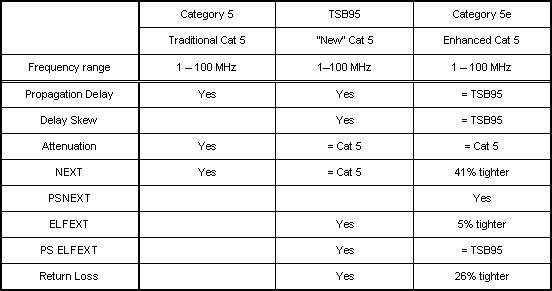1000BASE-T 超出类别 5?
This article is intended to clarify the physical layer requirements for Gigabit Ethernet (1000BASE-T) over balanced twisted pair cabling. The IEEE802.3ab standard for Gigabit Ethernet over balance twisted pair cabling was approved in 1999 年 6 月 28 日. This is important to note, since category 5e was not approved until January 2000 as ANSI/TIA/EIA-568-A-5. This would suggest that Gigabit Ethernet may not require category 5e performance. (You should install category 5e as a minimum today)
The following text is from IEEE802.3. You can download it for free from http://standards.ieee.org/getieee802/802.3.html
40.7 Link segment characteristics
1000BASE-T is designed to operate over a 4-pair Category 5 balanced cabling system. Each of the four pairs supports an effective data rate of 250 Mbps in each direction simultaneously. The term..
40.7.1 Cabling system characteristics
The cabling system used to support 1000BASE-T requires 4 pairs of Category 5 balanced cabling with a nominal impedance of 100 Ω. The cabling system components (cables, cords, and connectors) used to provide the link segment shall consist of Category 5 components as specified in ANSI/TIA/EIA-568-A:1995 and ISO/IEC 11801:1995. Additionally:
a) 1000BASE-T uses a star topology with Category 5 balanced cabling used to connect PHY entities.
b) 1000BASE-T is an ISO/IEC 11801 Class D application, with additional installation requirements and transmission parameters specified in Annex 40A.
c) The width of the PMD transmit signal spectrum is approximately 80 MHz.
d) The use of shielding is outside the scope of this standard.
40.7.2 Link transmission parameters
The transmission parameters contained in this sub clause are specified to ensure that a Category 5 link segment of up to at least 100 m will provide a reliable medium. The transmission parameters of the link segment include insertion loss, delay parameters, characteristic impedance, NEXT loss, ELFEXT loss, and return loss. Link segment testing shall .
When the IEEE was developing the Gigabit Ethernet standard, the installed base of data cabling was category 5. The IEEE set the goal for the active equipment vendors to ensure that the Gigabit Switches would work on the majority of the installed base.
The IEEE working group set the following objectives:
Comply with specifications for GMII of 802.3z.
Provide line transmission which supports full and half duplex operation.
Provide FCC Class A/CISPR or better operation
Support operation over 100 meters of Category 5 balanced cabling
Achieve bit Error Rate better than to 10-10
Support Auto-Negotiation (Clause 28)
Meet susceptibility requirements
Support the objectives of 802.3z of 1996 年 11 月 13 日
For example, the Intel 82544EI and 82544GC Gigabit Ethernet Controllers were specifically designed to run over the installed base of category 5.
BUT, vendors such as Intel required further information that was not initially available. To make it work, the IEEE needed to split the 1000 Mb/s into four paths, one for each of the four pairs. What caused the headache was that each pair would transmit and received at the same time full duplex. This meant that some new important test parameters had to be defined. Problem was that these were unknown for the installed base of category 5.
The new test parameters not fully defined in the field testing of category 5 were:
延迟时差
回波损耗
等电平远端串音 (ELFEXT)
Power Sum Equal Level Far End Crosstalk (PSELFEXT)
The IEEE turned to the TIA (Telecommunications Industry Association) and its members for help. The TIA was asked to come up with a set of limit lines for these missing parameters that would represent the majority of the installed base of category 5 cabling (>85 %). The IEEE would then work around these figures.
The TIA came up with the limit lines based on member feedback. The TIA/EIA cabling group then issued TIA/EIA-TSB 95: Additional Transmission Performance Guidelines for 100 Ω 4-Pair Category 5 Cabling. These requirements were incorporated into IEEE 802.3ab.
Telecommunication System Bulletins are NOT standards. Since TSB 95 was not an official standard, an addendum to the existing ANSI/TIA/EIA-568-A was required. This came in the form of addendum 5 and the introduction of category 5e. Cabling components had improved since the introduction of category 5 in 1995. The TIA/EIA cabling group (and marketing folks) took advantage of this and raised the bar for performance. The following table gives an indication to the level of performance increase:

This information will inevitably impact your decision to re-cable or not. If you are installing a new cabling system today, it should be at least category 5e ANSI/TIA-568-C. Category 5e obsoletes category 5.
There are many situations where re-cabling may not be an option especially if there are hazardous materials in the crawl space where the cable lies. If there is a need to run 1000BASE-T over a link, the user can verify the cabling system with a field tester first, to see if the cabling will support 1000BASE-T.
If the original installation was post 1995 and the installation good, you may be surprised to find that the link(s) will support 1000BASE-T.
If you have a DSP-4x00 or OMNIScanner, you can select either TIA/EIA TSB95 or 1000BASE-T in the standards menu. This is a channel test, so make sure you test the entire link from the switch to the PC. If you change the user cords, you will need to test again. However, I often recommend testing to category 5e first since many installations will meet this and it adds a little margin of assurance. If the Autotest should fail, then back off to 1000BASE-T or TSB-95.
Now to pre-empt your question on category 6. Do you need it? This is a decision that only you can make. You should always install the very best solution you can afford, after all, you only get one chance at this.
Finally, insist on certification results for any work.




